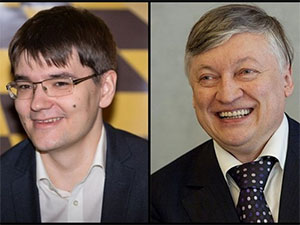


In the third round of the Baku Olympiad, Evgeny Tomashevsky of Russia was up against Viorel Iordachescu of Moldova. While Russia won the match easily with a score of 3:1, this particular game between Tomashevsky and Iordachescu was especially interesting. The reason? After the initial 20 moves the players reached the following position:
Tomashevsky - Iordachescu (Baku Olympiad 2016, Round 3)

White has a beautiful knight on d4 which secures him a small edge. What would you play?
As unbelievable as it may seem, Tomashevsky gave up his knight on d4 for the bishop on e6. Yes, he played the completely illogical 22.Nxe6. Why did a strong positional player like Tomashevsky play such an anti-positional move?
Before revealing the answer we would like to take you 31 years back in time! The date was 12th of September 1985. It was the 4th game of the World Championship Match between Karpov and Kasparov.

The Karpov-Kasparov World Championship Match of 1985
A lot of Queen's Gambit Declined were played in this Match. In fact, Garry Kasparov even authored a ChessBase DVD solely on that, having become one of the great experts as a result. After 20 moves in the fourth game this position was reached:
Karpov - Kasparov (1985 WCh, Game four)

The similarities with Tomashevsky-Iordachescu are quite obvious! And so you can quite easily guess what Karpov played here. Yes, of course, 20.Nxe6! Kasparov recaptured 20...fxe6. Let's check what Kasparov has to say about this move in his book Kasparov on Modern Chess Part II:
"Taking on e6 with the queen would have been the right decision. Now, however, White obtains a safe position with possibilities (albeit only slight) of improving it, whereas Black, with no active counterplay, is forced merely to passively keep an eye on the opponent's actions. The defence of the d5-pawn has been temporarily achieved, but this cannot be called a particular achievement: the weakness of the e6-pawn and the resulting weakening of a complex of light squares on the kingside give White a slight but persistent positional advantage. This factor cannot be immediately exploited: 22 Qg6? Qa5!, winning a pawn. The possible future invasion of the white queen on h7 will also not in itself solve anything, since after moving to e7 the black king will be safe enough. What is required of White is systematic play, the essence of which can be described as follows: the consolidation of his position on the queenside, the switching of his queen to the kingside, the opening of the position by e3-e4, and only then the mounting of an attack on the light squares, making use of the now open e-file. In the game Karpov skillfully put all these ideas into practice, but, of course, not without substantial 'help' on my part."
Have a look at the remainder of the game with comments from Kasparov, and learn the art of positional play from Anatoly Karpov:

The entire plan explained above, after 21...fxe6, was put into practice extremely strongly and consistently by Karpov.
Once you have seen this game and understood the value of giving up your strong knight for the passive bishop on e6, Tomashevsky's decision of 22.Nxe6 against Iordachescu becomes much clearer.

In the game he had quite a bit of pressure on his opponent and even won a pawn. But in the end he wasn't able to convert it into a full point. Here's the game for you to play and think over:
Tomashevsky - Iordachescu (Baku Olympiad 2016, Round 3)


On the left is Tomashevsky - Iordachescu, 2016 and on the right is Karpov - Kasparov, 1985!

Chess becomes easier when you know your classics!
It was exactly with this intention that I recorded the ChessBase DVD "Learn from the Classics". The idea is to learn patterns and ideas from the great masters of the past, store them in your memory and use them at the appropriate moments in your game! Finding ideas like Nxe6 and dominating the light squares over the board, is not so easy. But if you have seen a classic game where this is implemented, things are pretty straightforward!
Learn from the ClassicsBy Sagar Shah €29.90 • Video running time: 4 hours 45 min (English) This DVD can be purchased as a hard copy or it can be downloaded directly from the Internet, that way sparing you the few days needed for it to arrive by post. Order this Fritztrainer in the ChessBase Shop |
| Advertising |